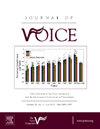Autoimmune Associated Vocal Fold Lesions: A Systematic Review
IF 2.5
4区 医学
Q1 AUDIOLOGY & SPEECH-LANGUAGE PATHOLOGY
引用次数: 0
Abstract
Objective
While Autoimmune Associated Vocal Fold Lesions (AaVFLs) have been described in many reports, there is no consensus on best practices in management. The purpose of this systematic review is to clarify the characteristics and treatment of dysphonia in the setting of AaVFLs.
Study Design
Systematic review
Methods
Pubmed and OVIDMedline and Google Scholar were searched, including terms related to (1) Vocal fold/cord, rheumatoid node/nodule, bamboo nodes/nodules, laryngeal deposits/nodes/nodules and (2) Autoimmune diseases/syndromes, connective tissue disease.
Results
Twenty-one studies with 83 patients diagnosed with AaVFLs were included. AaVFLs occurred predominantly in females in the 4th or 5th decade of life, with an overall mean age of 39.8 (SD = 12.8). Autoimmune or connective tissue disease was established prior to presentation to an otolaryngologist in 75.9% (44/58) of patients. Bilateral lesions were present in 83.8% (57/68) of patients. Treatment modalities included medical therapy alone (28.1%), voice therapy alone (17.5%), surgical treatment alone (7.0%), combination of medical and voice therapy (33.3%), and combination of surgical, medical and voice therapy (7.0%). All patients treated with voice therapy had voice improvement; lower rates were seen with solo medical (4/14 improved, 28.6%) or surgical therapy (3/6 improved, 50%).
Conclusion
AaVFLs occur predominantly in women in their 30′s to 50′s and are associated with a variety of autoimmune conditions. A significant number of patients (25%) present to the Otolaryngologist without an established autoimmune diagnosis. While treatment outcomes are not robustly reported, a significant number of patients with AAVFLs treated with voice therapy alone or voice therapy in combination with other treatment modalities (medical or surgical) experience subjective improvement in voice quality and function.
自身免疫相关性声带皱褶病变:系统回顾
目的:虽然许多报道都对自身免疫相关性声带褶皱(AaVFLs)进行了描述,但在最佳治疗方法方面尚未达成共识。本系统综述旨在阐明 AaVFLs 患者发音障碍的特征和治疗方法:系统综述 方法:检索了 Pubmed 和 OVIDMedline 以及 Google Scholar,包括以下相关术语:(1)声带褶皱/声带、类风湿结节/结节、竹节/结节、喉沉积物/结节/结节;(2)自身免疫性疾病/综合征、结缔组织病:结果:共纳入 21 项研究,83 名患者被诊断为 AaVFLs。AaVFL主要发生在第四或第五个十年的女性身上,总平均年龄为39.8岁(SD = 12.8)。75.9%(44/58)的患者在向耳鼻喉科医生就诊前已确定患有自身免疫性疾病或结缔组织疾病。83.8%(57/68)的患者存在双侧病变。治疗方式包括单纯药物治疗(28.1%)、单纯嗓音治疗(17.5%)、单纯手术治疗(7.0%)、药物和嗓音联合治疗(33.3%)以及手术、药物和嗓音联合治疗(7.0%)。所有接受嗓音治疗的患者的嗓音都有所改善;单独接受药物治疗(4/14 例,28.6%)或手术治疗(3/6 例,50%)的患者嗓音改善率较低:AaVFL主要发生在30至50岁的女性身上,与多种自身免疫性疾病有关。相当多的患者(25%)在就诊耳鼻喉科时并未确诊为自身免疫性疾病。虽然治疗结果尚未得到充分报道,但在单独接受嗓音治疗或嗓音治疗与其他治疗方法(药物或手术)相结合的 AAVFLs 患者中,有相当一部分人的嗓音质量和功能都得到了主观改善。
本文章由计算机程序翻译,如有差异,请以英文原文为准。
求助全文
约1分钟内获得全文
求助全文
来源期刊

Journal of Voice
医学-耳鼻喉科学
CiteScore
4.00
自引率
13.60%
发文量
395
审稿时长
59 days
期刊介绍:
The Journal of Voice is widely regarded as the world''s premiere journal for voice medicine and research. This peer-reviewed publication is listed in Index Medicus and is indexed by the Institute for Scientific Information. The journal contains articles written by experts throughout the world on all topics in voice sciences, voice medicine and surgery, and speech-language pathologists'' management of voice-related problems. The journal includes clinical articles, clinical research, and laboratory research. Members of the Foundation receive the journal as a benefit of membership.
 求助内容:
求助内容: 应助结果提醒方式:
应助结果提醒方式:


